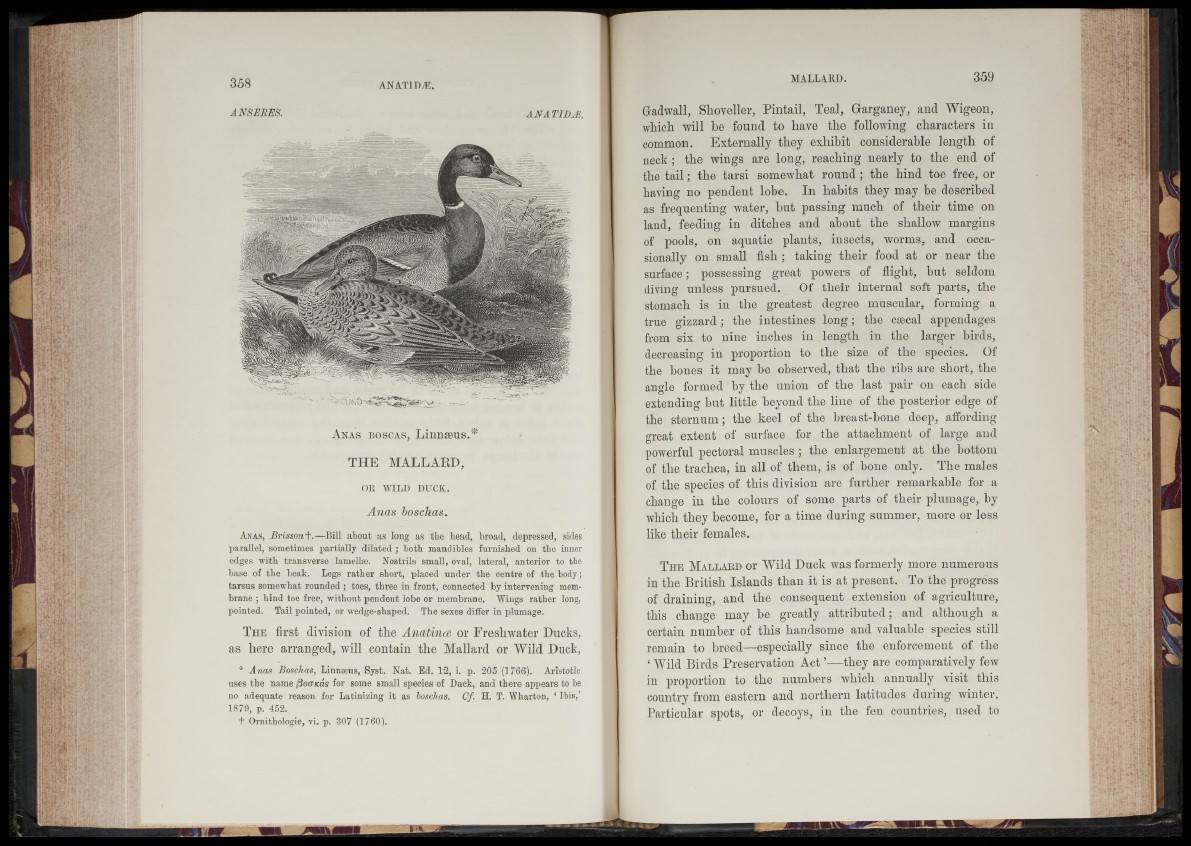
358 AN ATI DTE,
A NSEBES. A JVA TIDJi.
A n a s b o sc a s , Linnaeus.*
THE MALLARD,
OR WILD DUCK.
Anas boschas.
Anas, Brisson+.—Bill about as long as the head, broad, depressed, sides
parallel, sometimes partially dilated ; both mandibles furnished on the inner
edges with transverse lamellae. Nostrils small, oval, lateral, anterior to the
base of the beak. Legs rather short, placed under the centre of the body;
tarsus somewhat rounded ; toes, three in front, connected by intervening membrane
; hind toe free, without pendent lobe or membrane. Wings rather long,
pointed. Tail pointed, or wedge-shaped. The sexes differ in plumage.
The first division of the Anatince or Freshwater Ducks,
as here arranged, will contain the Mallard or Wild Duck,
* Anas Boschas, Linnaeus, Syst. Nat. Ed. 12, i. p. 205 (1766). Aristotle
uses the name ftoands for some small species of Duck, and there appears to be
no adequate reason for Latinizing it as boschas. Cf. H. T. Wharton, ‘ Ibis,’
1879, p. 452.
t Ornithologie, vi. p. 307 (1760).
Gadwall, Shoveller, Pintail, Teal, Garganey, and Wigeon,
which will be found to have the following characters in
common. Externally they exhibit considerable length of
neck ; the wings are long, reaching nearly to the end of
the tail; the tarsi somewhat round ; the hind toe free, or
having no pendent lobe. In habits they may be described
as frequenting water, but passing much of their time on
land, feeding in ditches and about the shallow margins
of pools, on aquatic plants, insects, worms, and occasionally
on small fish; taking their food at or near the
surface; possessing great powers of flight, but seldom
diving unless pursued. Of their internal soft parts, the
stomach is in the greatest degree muscular, forming a
true gizzard; the intestines long; the caecal appendages
from six to nine inches in length in the larger birds,
decreasing in proportion to the size of the species. Of
the bones it may be observed, that the ribs are short, the
angle formed by the union of the last pair on each side
extending but little beyond the line of the posterior edge of
the sternum; the keel of the breast-bone deep, affording
great extent of surface for the attachment of large and
powerful pectoral muscles ; the enlargement at the bottom
of the trachea, in all of them, is of bone only. The males
of the species of this division are further remarkable for a
change in the colours of some parts of their plumage, by
which they become, for a time during summer, more or less
like their females.
The Mallard or Wild Duck was formerly more numerous
in the British Islands than it is at present. To the progress
of draining, and the consequent extension of agriculture,
this change may be greatly attributed; and although a
certain number of this handsome and valuable species still
remain to breed—especially since the enforcement of the
‘ Wild Birds Preservation Act ’-—they are comparatively few
in proportion to the numbers which annually visit this
country from eastern and northern latitudes during winter.
Particular spots, or decoys, in the fen countries, used to